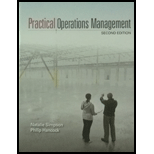
Concept explainers
Interpretation:
The EOQ and the EPQ recommend nearly identical order sizes, and its relationship with the concepts of instantaneous and no instantaneous relationships.
Concept Introduction:
The formula to calculate economic order quantity is
Explanation of Solution
Given information:
The given formula is,
It is a measure to determine the optimal order size of the inventory where the firm cannot replenish, it inventory instantly. In other words, the economic production quantity he evaluate the optimal order size when the inventory increase steadily after the order is place . this concept is applicable when the film produces its own inventory for consumption.
D refers to the annual demand
S refers to the annual fixed ordering cost
H refers to the annual holding costs of the inventory
P refers to the production rate inventory
d refers to the daily demand
Instantaneous replenishment:
It refers to the replenished of inventory immediately after the film places an order for the inventory. The economic order quantity assumes that the firm receives inventory immediate after it places the order.
Determine when the economic order quantity(EOQ) would be equal to economic production quantity(EPQ):
The economic order quantity assumes instantaneous replenishment and consider only the annul demand D order costs S and the holding cost H
On the other hand, the economic production quantity assumes non- instantaneous is replenishment and consider the ratio of daily production P to daily demand d
Conclusion:
Economic order quantity assumes that the replenishment of inventory is instantaneous. The economic production quantity consider the inventory non- instantaneous and hence, the rate daily production to daily demand. The economic order quantity will be equal to economic production quantity, if the daily demand or daily consumption of the order zero.
Want to see more full solutions like this?
Chapter 10 Solutions
Practical Operations Management
- The chapter presented various approaches for the control of inventory investment. Discuss three additional approaches not included that might involve supply chain managers.arrow_forwardWhy do we use "Specifications or bill of material" in the dependent inventory model?arrow_forwardWhen cycle counting inventory, why do experts recommend a lower acceptable error tolerance for A items than B or C items?arrow_forward
- The materials manager for a billiard ball maker must periodically place orders for resin, one of the raw materials used in producing billiard balls. She knows that manufacturing uses resin at a rate of 50 kilograms each day, and that it costs $.04 per day to carry a kilogram of resin in inventory. She also knows that the order costs for resin are $100 per order, and that the lead time for delivery is four days. If the order size was 1,000 kilograms of resin, what would be the average inventory level?arrow_forwardWhat is the EOQ and what is the lowest total cost?arrow_forwardReorder Point Ordering: Average daily demand ( d) is 5 units with a std. dev. (od) of 1 unit. Average lead time ( LT) is 24 days with a std. dev. (OLT) of 1 day. The inventory manager wants to operate within 3 std. deviations (z = 3). Find the reorder point (ROP) and safety stock (S). ROP=141, SS=120 ROP=141, SS=21 ROP=120, SS=21 ROP=21, SS=141arrow_forward
- Define each of the following terms: c. Economic Ordering Quantity (EOQ); EOQ model; EOQ rangearrow_forwardDiscuss some of the issues that a small pizza restaurant might face in inventory management. Would a pizza restaurant use a fixed order quantity or period system for fresh dough (purchased from a bakery on contract)? What would be the advantages and disadvantages of each in this situation?arrow_forwardWhat is the ABC analyses! fundamental premise? What are the three measures involved in performing an ABC inventory analysis?arrow_forward
- Maroons Medical Supplies, Inc. must order masks from its supplier in lots of 1 dozen boxes. Given the information provided below, complete the following table: Annual demand 26,000 dozen Cost per order placed P30 Carrying cost 20% Price per dozen P7.80 Order Size (Dozen) 250 500 1,000 2,000 13,000 26,000 Number of orders Average inventory Carrying cost Order cost Total cost 1. What is the EOQ? Please include/fill the table and solve for EOQ. Thank you so much!arrow_forwardUpon delivery, only the items quantity ordered on the PO(pruchase order) is received and a Daly Receiving Report (DRR)made by the supplier at the time of delivery. True or false?arrow_forwardAnnual demand= 360 units Holding cost per year = 1 $ per unit Ordering cost = $ 100 per order Compute EOQ , total cost(holding and ordering cost),no of order per year and expected time (days) between orders(Assuming a 300-day work ) and what would the actual total holding and ordering costs be if the annual demand was actually higher than estimated i.e 500 units instead of 360 units, but the EOQ established above is used. If demand for an item is 3 units per day, and delivery lead time is 15 days, what would be the re-order point?arrow_forward
 Purchasing and Supply Chain ManagementOperations ManagementISBN:9781285869681Author:Robert M. Monczka, Robert B. Handfield, Larry C. Giunipero, James L. PattersonPublisher:Cengage Learning
Purchasing and Supply Chain ManagementOperations ManagementISBN:9781285869681Author:Robert M. Monczka, Robert B. Handfield, Larry C. Giunipero, James L. PattersonPublisher:Cengage Learning
